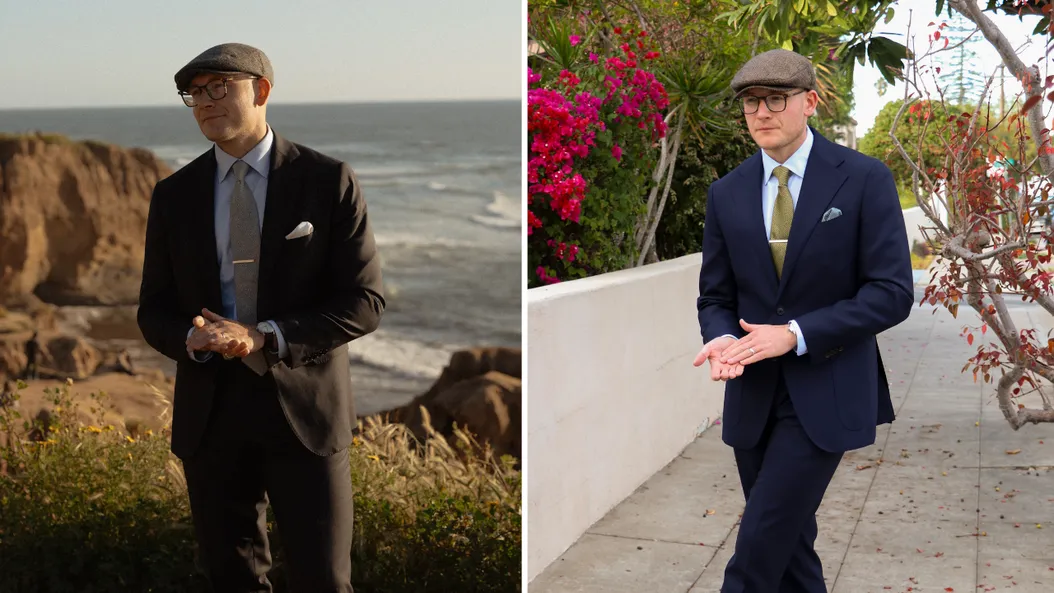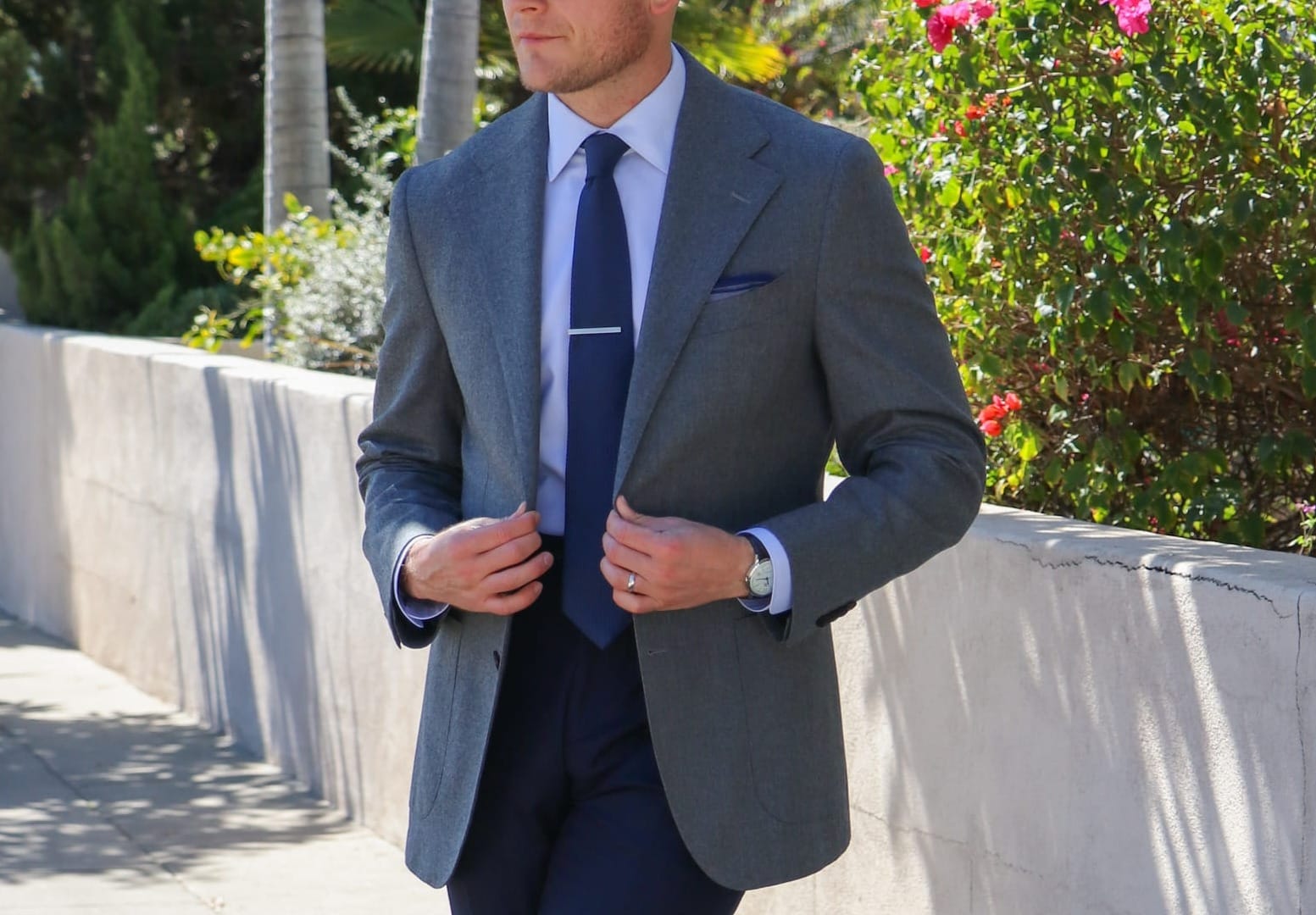
What is a Capsule Wardrobe?
In the purest sense, a capsule wardrobe is a collection of versatile pieces that all mix and match well to create a variety of outfit combinations. These can be particularly helpful for men because they allow you to accomplish more with less.
Benefits of a Capsule Wardrobe
A business casual capsule wardrobe simplifies life and reduces anxiety. By concentrating on the essentials in one's closet, any man can create a "fool-proof" wardrobe by ensuring that each piece pairs well together.
This often means that, in most cases, every shirt pairs well with every pair of pants, and every pair of shoes complements both, among other combinations.
A capsule wardrobe can be efficient and effective for men who want to simplify their daily outfits.
Moreover, there's the advantage of long-term savings. By purchasing items upfront, we can relieve the pressure on our finances by clearly identifying our needs from the beginning rather than spending more later by buying items first and then figuring out their place in our outfit rotation.
It’s not for everyone, but it works for many professionals who want to look polished and put-together without sacrificing comfort and style.
A capsule wardrobe reduces decision fatigue and makes getting dressed easier. It helps you pinpoint gaps in your wardrobe and concentrate on timeless pieces.
Understanding the Business Casual Dress Code
The business casual dress code for men seems to be ever-evolving. Over the years, it has expanded to include more options for office wear, from blazers and sport coats with dress shoes to polo shirts, chinos, and white sneakers.
Business casual is a style that balances formal office wear with relaxed attire, aiming for a professional yet approachable look. For men, business casual attire should generally fall between a full-on suit and weekend casual attire.
You might often hear about dress codes that are business casual-adjacent, such as "smart casual" or "sharp casual." These usually fall squarely in the same category as contemporary business casual outfits, and everything I will cover throughout this guide will undoubtedly encompass the smart and sharp casual dress code while remaining quintessentially business casual.
- No light-wash jeans.
- No medium-wash jeans.
- No athletic (running) shoes.
- No work boots.
- No shorts of any kind.
Depending on who you are, these guidelines may sound a bit "old-fashioned." However, they are a surefire way to ensure that you are well-prepared for your place of work or a networking function.
Building a Business Casual Capsule Wardrobe (With Only 15 Pieces)
This business casual capsule wardrobe is designed to suit most men of nearly any body type, accommodating both colder and warmer climates; however, it does not provide options for consistently hot or frigidly cold regions all year round.
I want to clarify that the wardrobe I am about to describe works well for many areas but certainly not all.
Before making any purchases, consider affordable and premium options for various budgets. The key is identifying flattering and versatile pieces that can be worn frequently. Let's dive in.
Piece #1: Brown Suede Oxford Dress Shoes
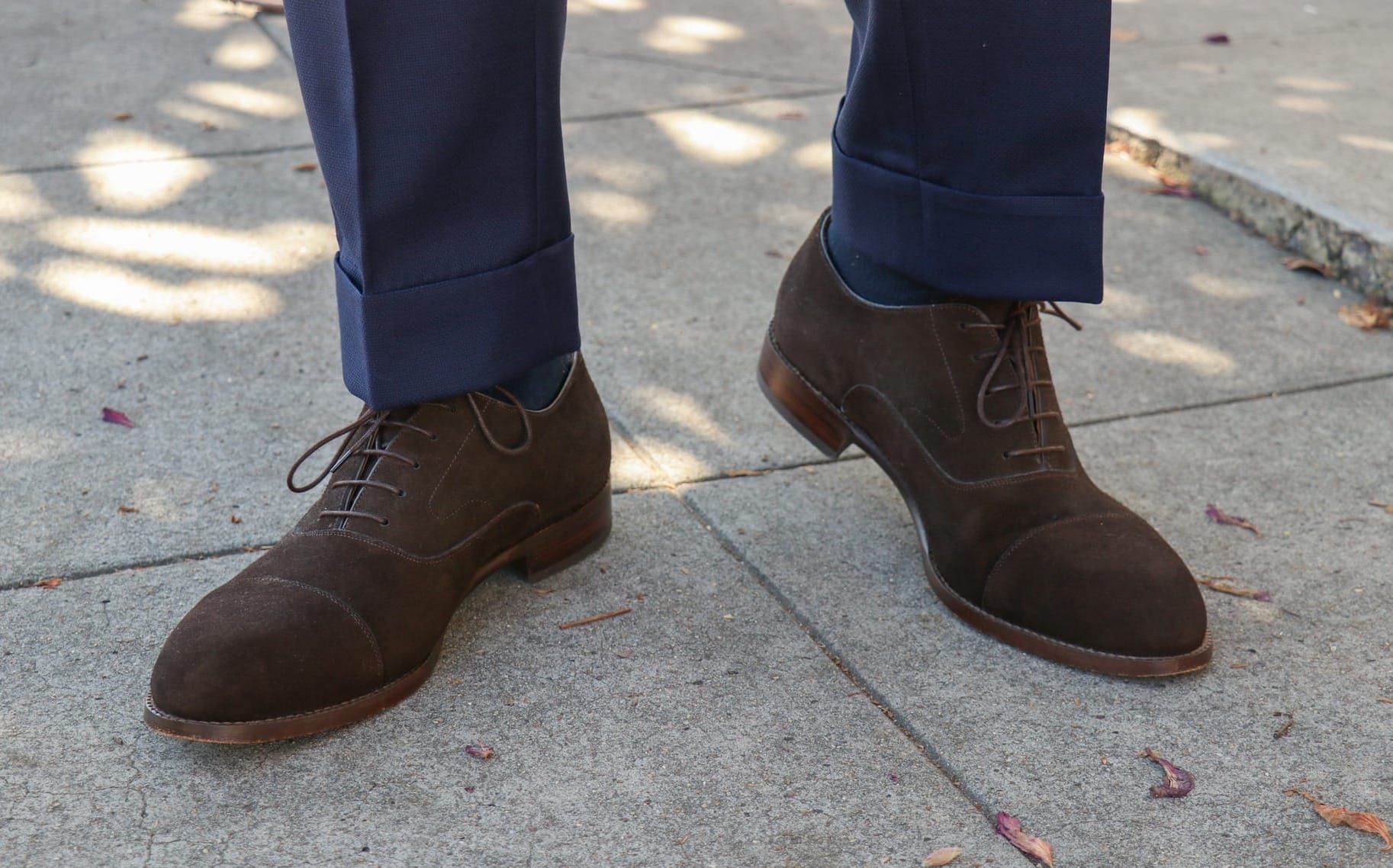
Regular brown leather oxfords would work just fine, but I believe the deep brown suede complements the other textured items on this list. Suede is also a less formal material, yet the silhouette of a traditional oxford dress shoe elevates it to a dressier level—creating a nice balance between elegance and ruggedness.
Piece #2: Brown Leather Loafers

Loafers are equally elegant for business casual outfits but are decidedly more relaxed. Quality leather loafers can convey a laid-back appearance without appearing too casual.
Like the suede oxfords previously mentioned, brown is the best color choice because it is classic and complements the other neutral-colored pieces on this list.
Piece #3: White Leather Sneakers
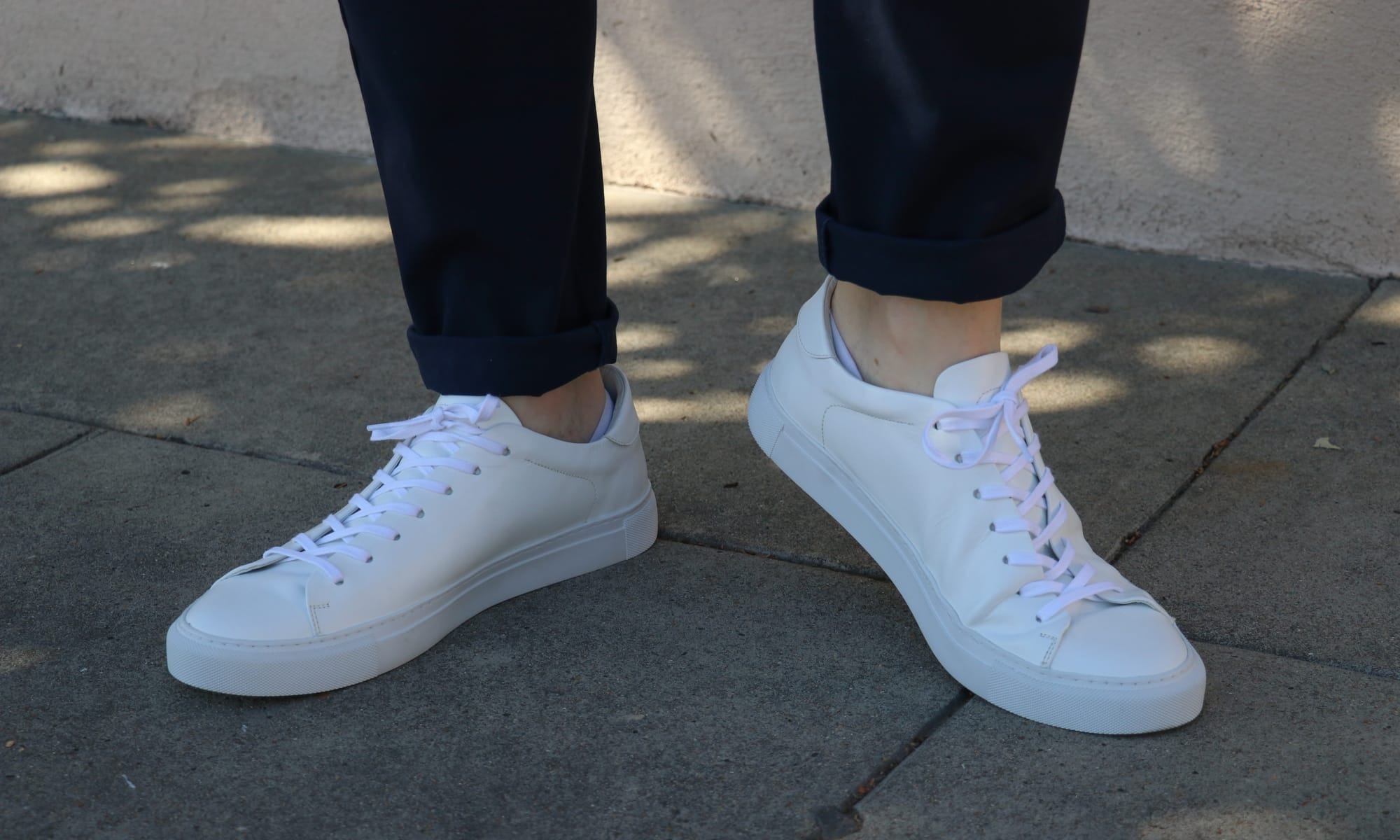
White sneakers are another highly versatile shoe type, but they are certainly the most casual footwear option I recommend to any man for a dress code like this.
A pair of clean white leather sneakers are best reserved for modern "smart casual" outfits (more on this in a bit), but they are surprisingly versatile for all manner of occasions.
Traditionally, wearing white sneakers is unacceptable for a business casual dress code. However, given the widening definition of a "professional look" in today's workplaces, I believe there are numerous opportunities for men to incorporate sneakers into their office wardrobe rotations.
Piece #4: Brown Cap-Toe Boots
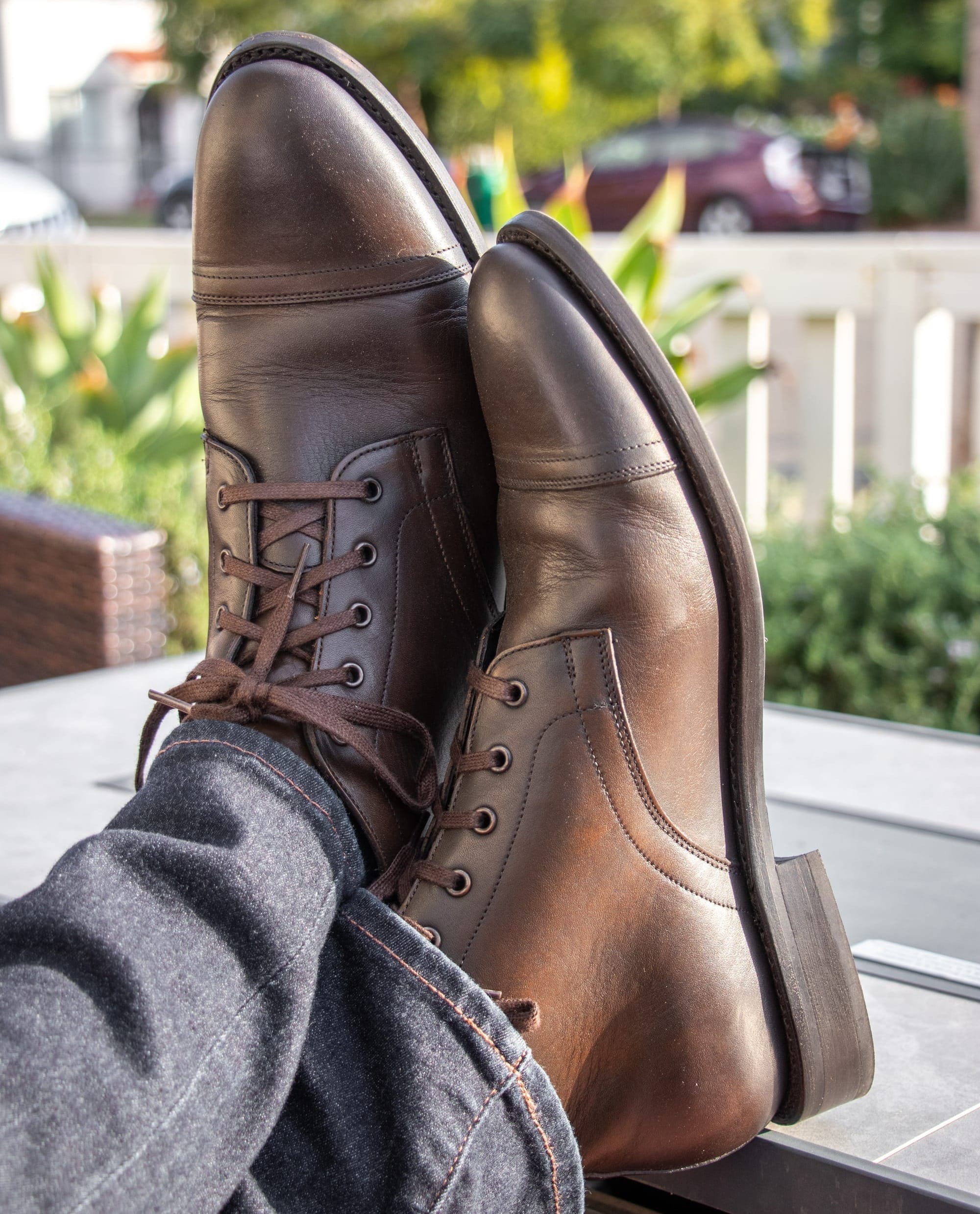
A stylish pair of dressy boots will broaden your footwear options and perfectly enhance your business attire, especially during the chilly fall and brisk winter. To get started, I recommend classic brown leather cap-toe lace-up boots.
Piece #5: Khaki Chinos
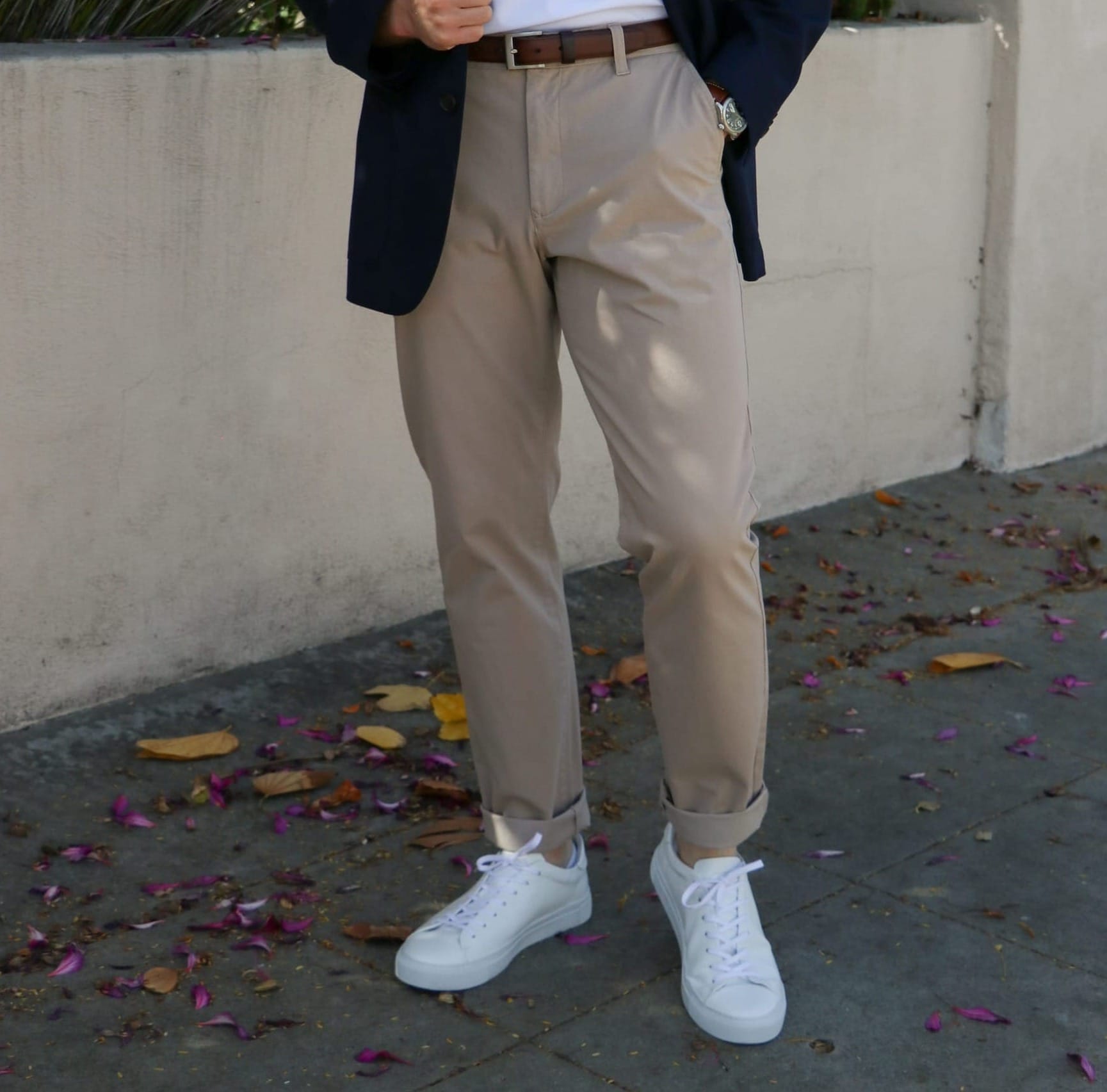
Classic chinos are quite possibly the most versatile pants on the planet. They can be worn in various ways, whether you're dressing up for the office or dressing down for a more casual business luncheon. These pants are an excellent workhorse staple that will never cease to be stylish.
Khaki is a color, and chinos are pants. Regarding any capsule wardrobe, I believe the first pair of chinos should be a classic khaki color. These will serve as an excellent staple in your closet, whether for a business casual dress code or everyday life.
Piece #6: Navy Chinos
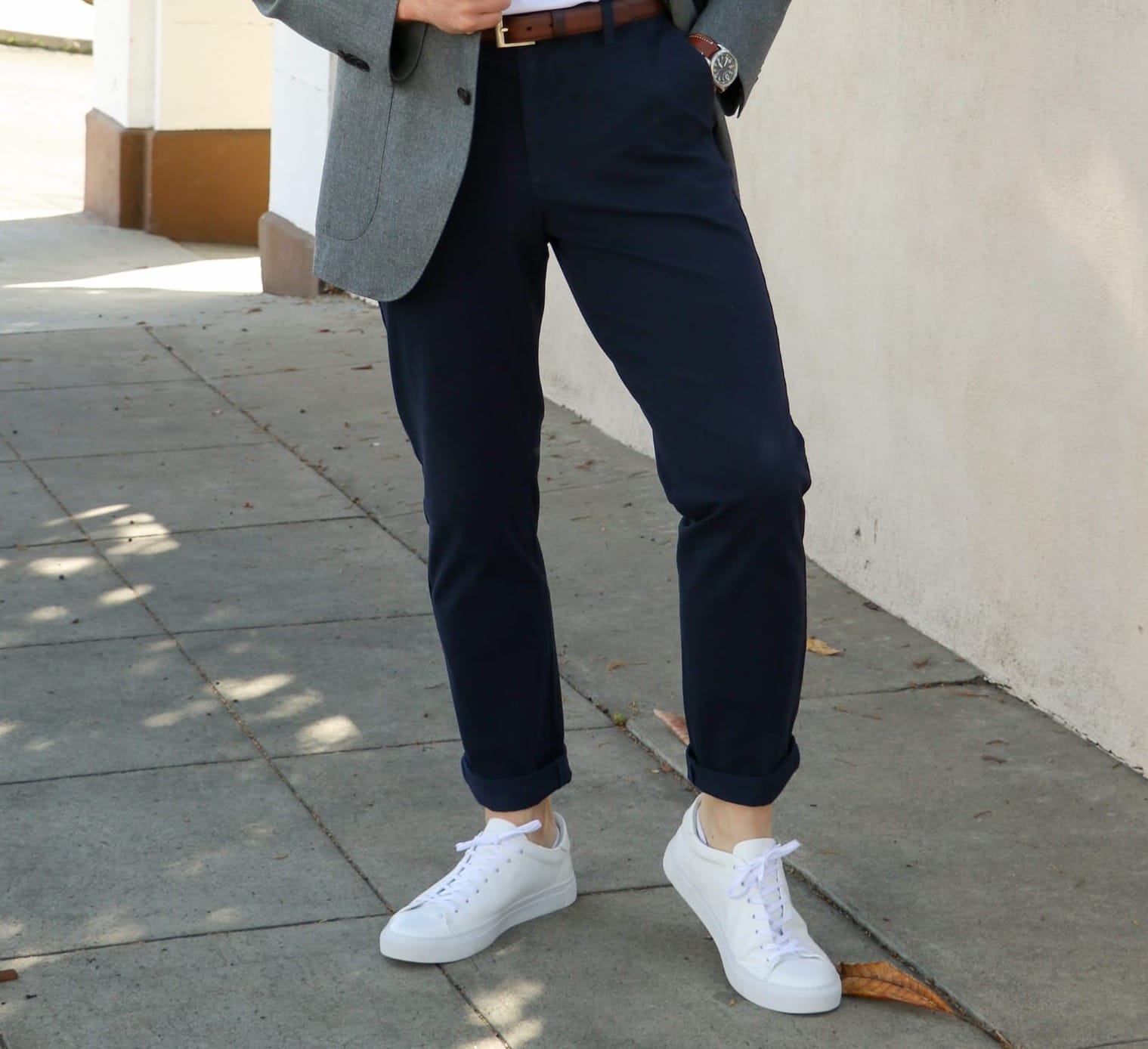
After purchasing a pair of khaki chinos, I recommend snagging a pair of navy blue chinos for the same reasons as the previous pair. They are timeless and versatile.
Piece #7: Dark Wash Jeans
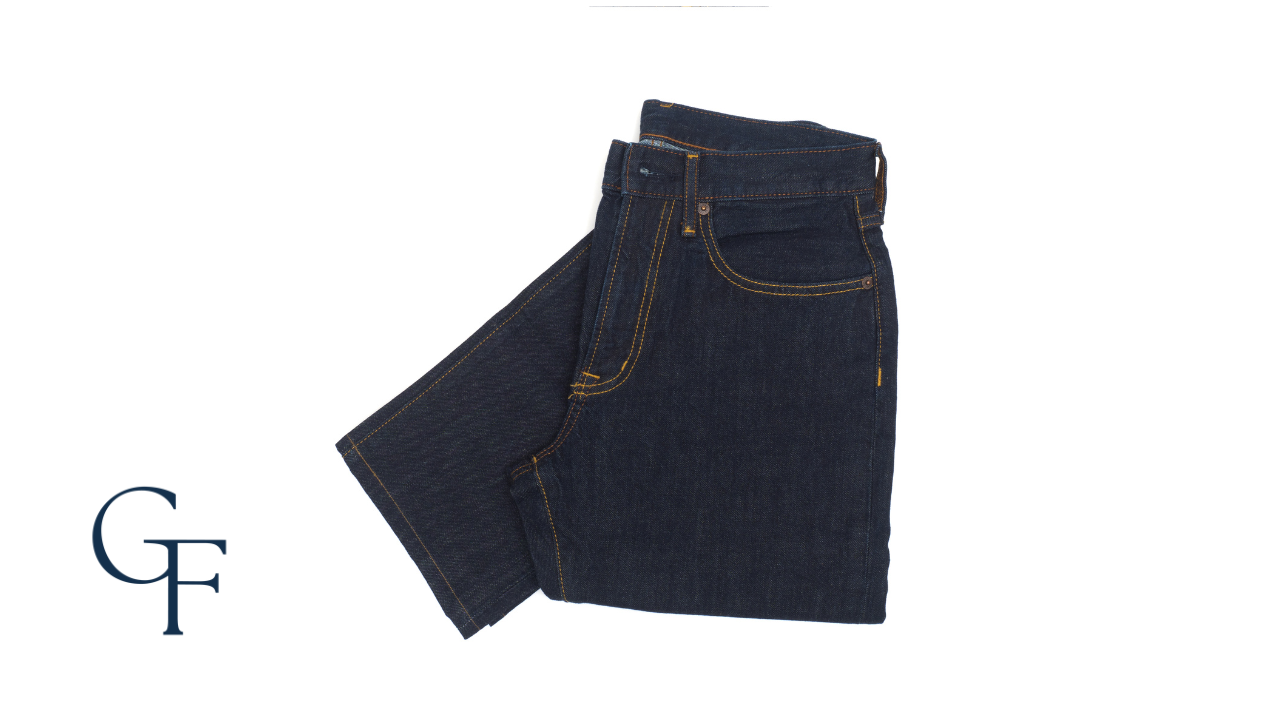
Some people will tell you never to wear jeans as part of a classic business casual wardrobe.
However, as long as you only opt for dark wash denim jeans that are clean, devoid of rips, tears, or distressing, and tailored well to fit your physique, they can be a great addition to your wardrobe, complementing your blazers or sport coats.
While these types of pants haven't always been accepted in more traditional business casual settings, they are highly versatile. They can provide much-needed texture to complement your other dressier pieces that might sport patterns and texture.
Piece #8: White Pique Polo Shirt
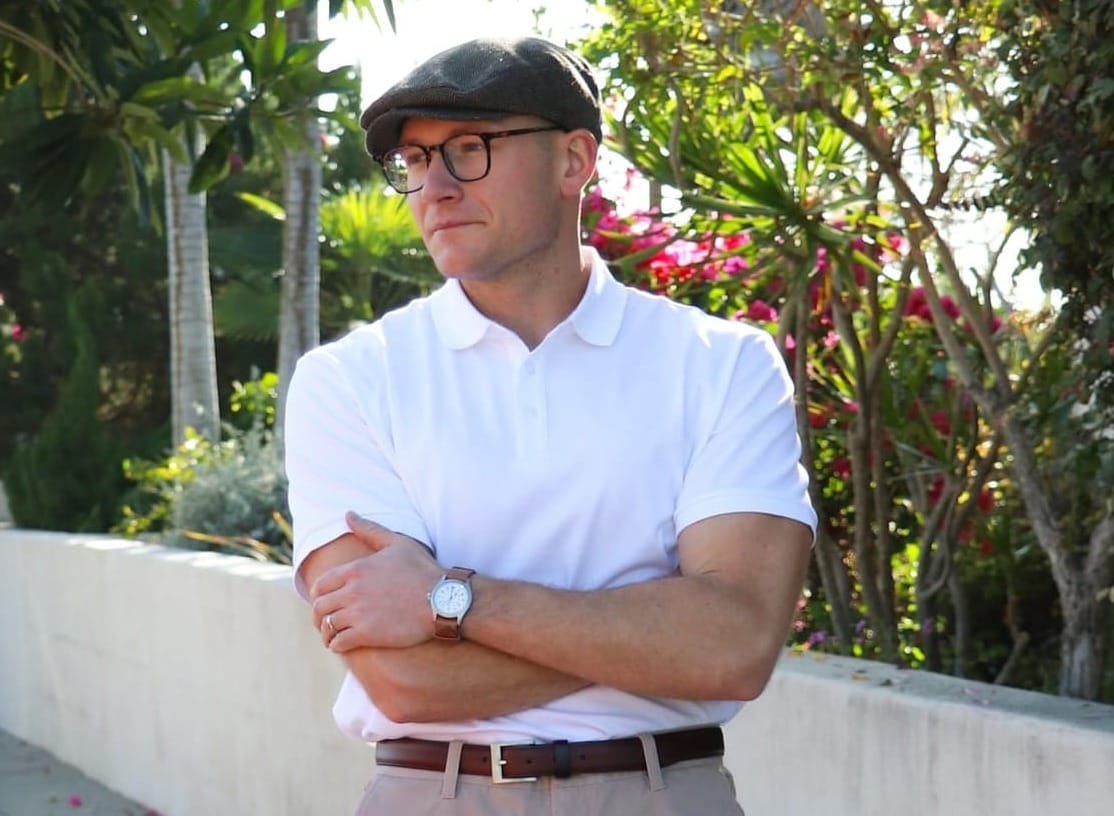
The polo shirt is a timeless and handsome necessity that every man must prioritize having in his closet. Not all polo shirts are created equal, though. The 100% cotton pique polo shirt is the way to go for business casual settings.
To get started, I recommend a white shirt.
Piece #9: White Dress Shirt
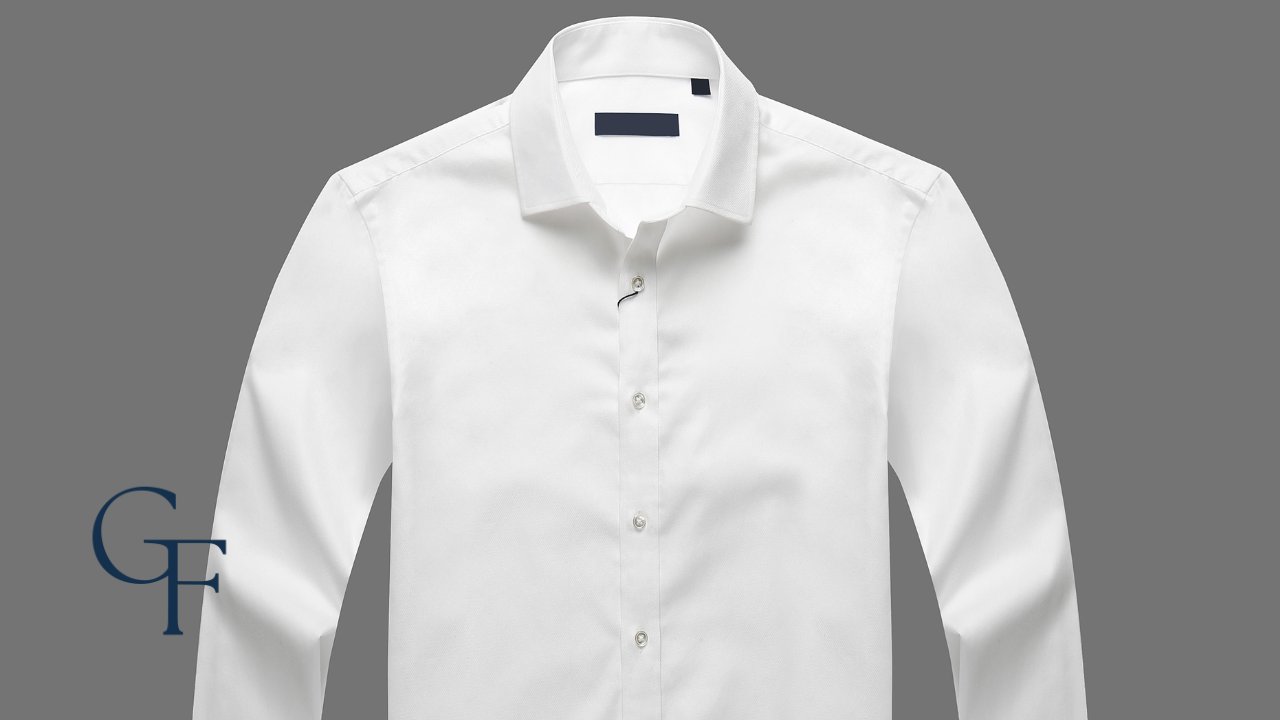
Dress shirts pair nicely with blazers, sport coats, dress pants, and chinos. To get started, I recommend sticking with the tried-and-true white dress shirt.
Piece #10: Ice Blue Oxford-Cloth Dress Shirt
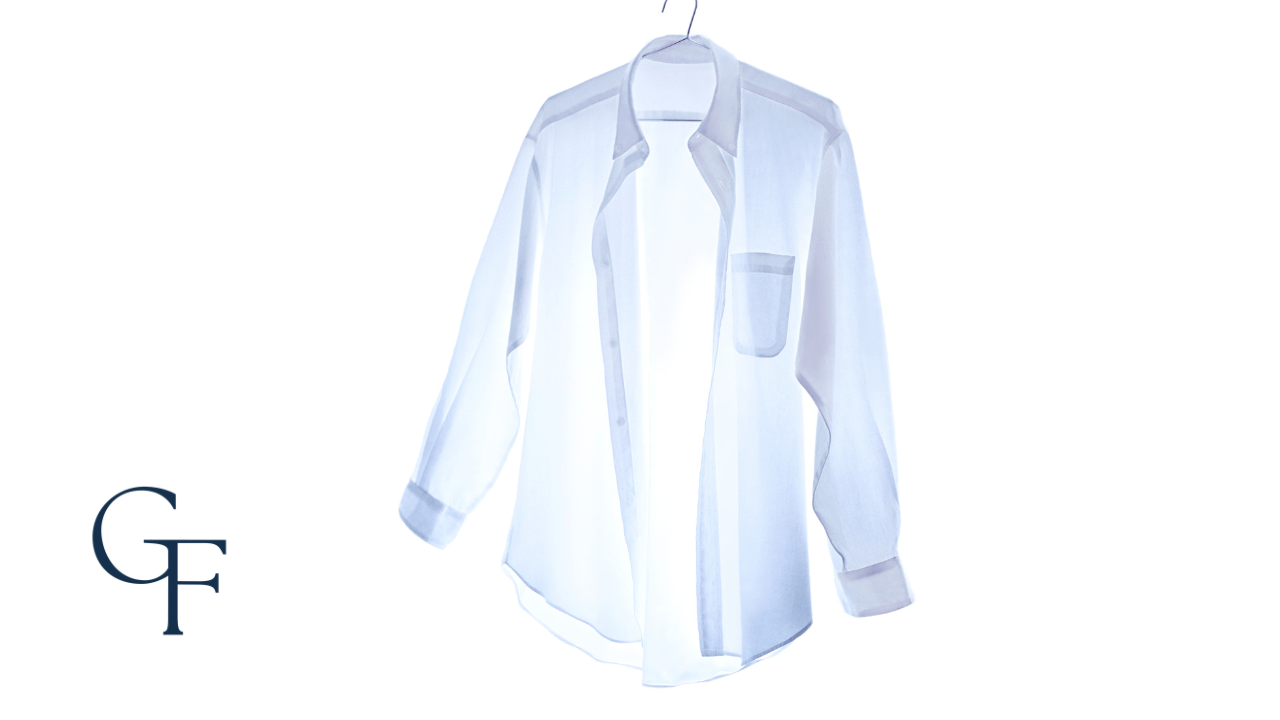
After picking up a white dress shirt, I recommend an ice-blue oxford-cloth dress shirt. It is light enough to substitute for the white shirt but adds just enough color to enhance the other neutral pieces on this list.
Piece #11: Navy V-Neck Sweater
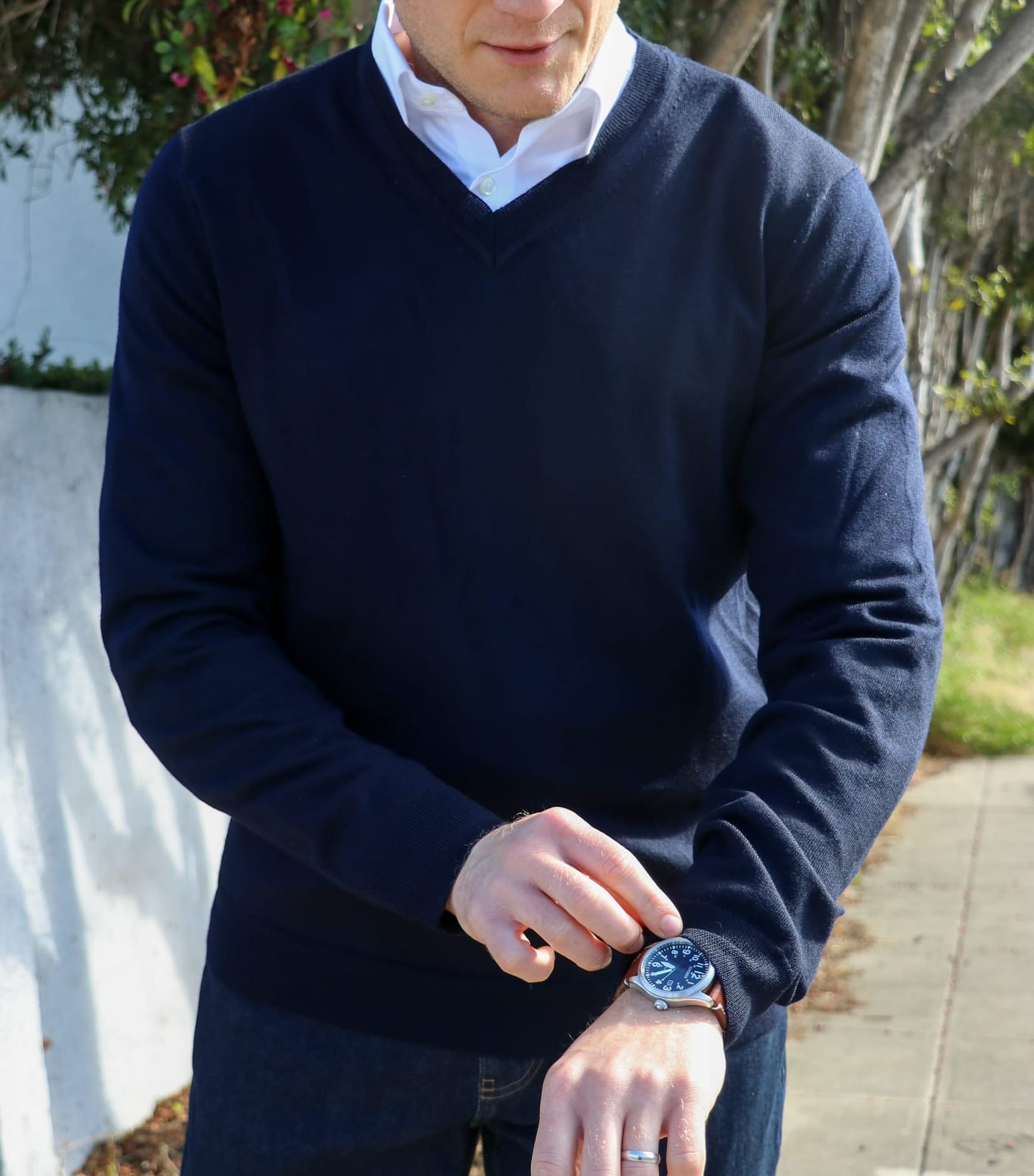
Like classic crewneck sweaters, the arguably less versatile but equally timeless v-neck sweaters are ideal for pairing, especially when layered over a dress shirt.
Sweaters are great tops or midlayers, providing warmth and texture while elevating nearly every outfit combination. Most classic neutral colors, such as charcoal, tan, ash, or olive green, would complement this piece well.
For this list, I am selecting a classic navy blue sweater.
Piece #12: Navy Wool Hopsack Suit
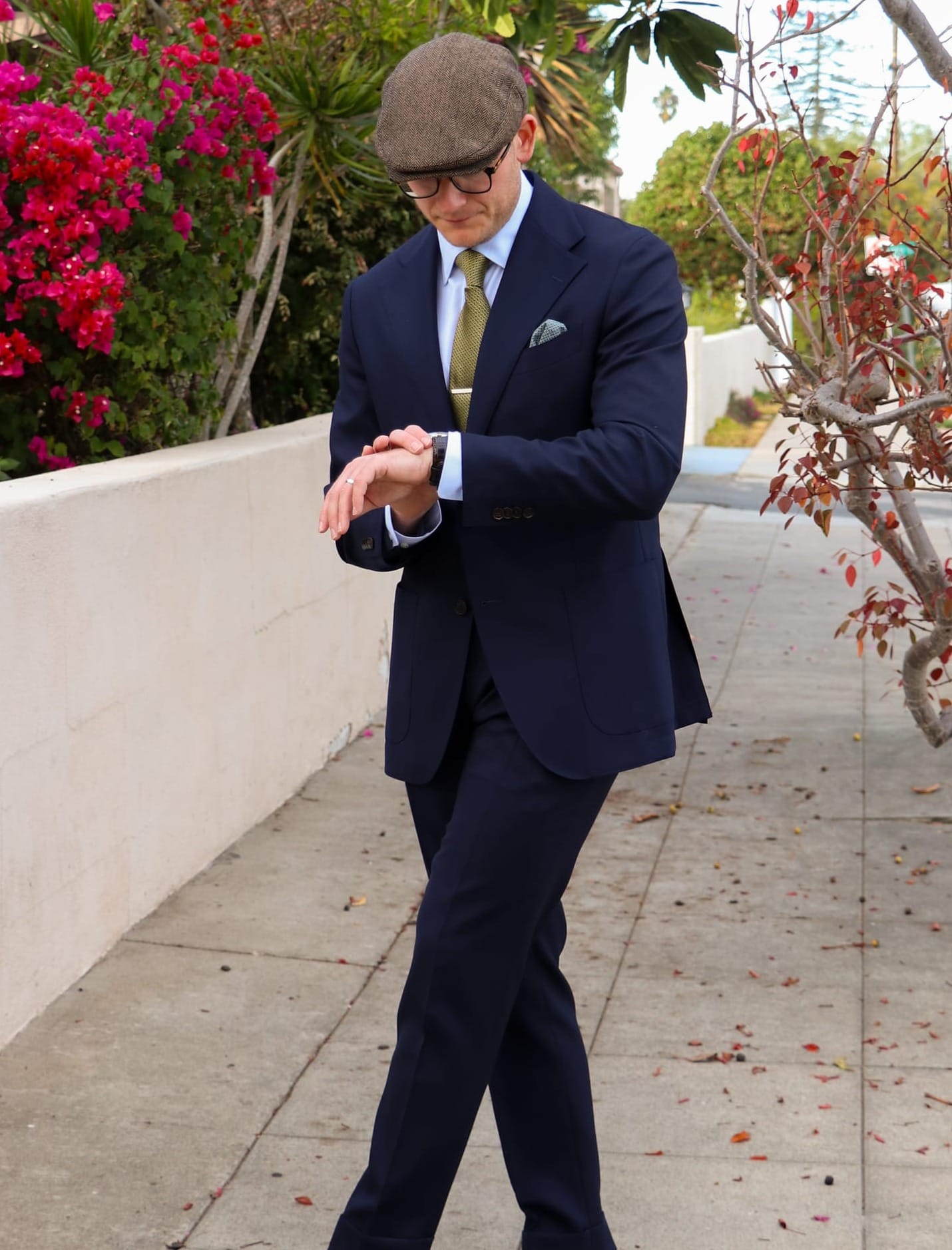
You may wonder why I'm including a full suit. Bear with me.
Yes, a suit is a stand-alone piece because, by definition, it must include a jacket and a set of trousers that match in fabric, pattern, and color.
Hopsack is not a material but a type of woolen weave. Its basket-like weave offers a brilliant yet subtle texture. This means it pairs very well with other garments with a noticeable texture (e.g., denim, cotton twill, corduroy, linen, etc.).
The way wool is woven for hopsack also makes it highly breathable. This means it can be very effective as a lightweight and breezy fabric in the spring and summer months while utilizing its subtle texturing significantly in the fall and winter.
Being able to wear fabrics like this all year round makes a four-season fabric what it is: one that can be worn during all four seasons, whether for comfort or style. As you can see from the example above, a navy blue hopsack suit looks regal in complete form.
Piece #13: Mid-Gray Flannel Suit
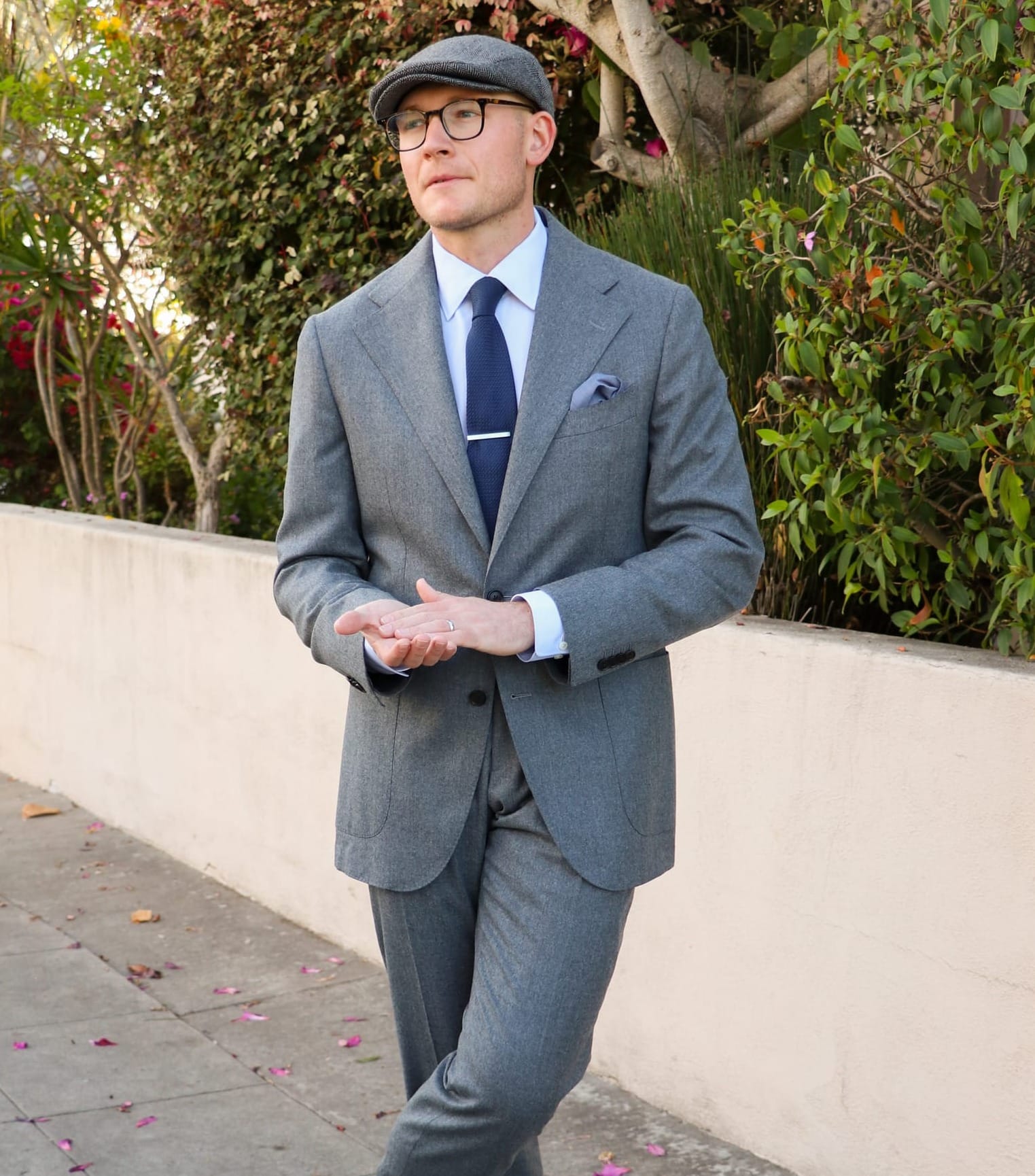
Flannel is a much cozier fabric often reserved for fall and winter. While it can work fine for spring and summer, it's worth clarifying that it works better during the colder seasons.
Flannel is not a four-season fabric like the previously mentioned hopsack material, but it is still a highly versatile option.
Piece #14: Navy Grenadine Necktie
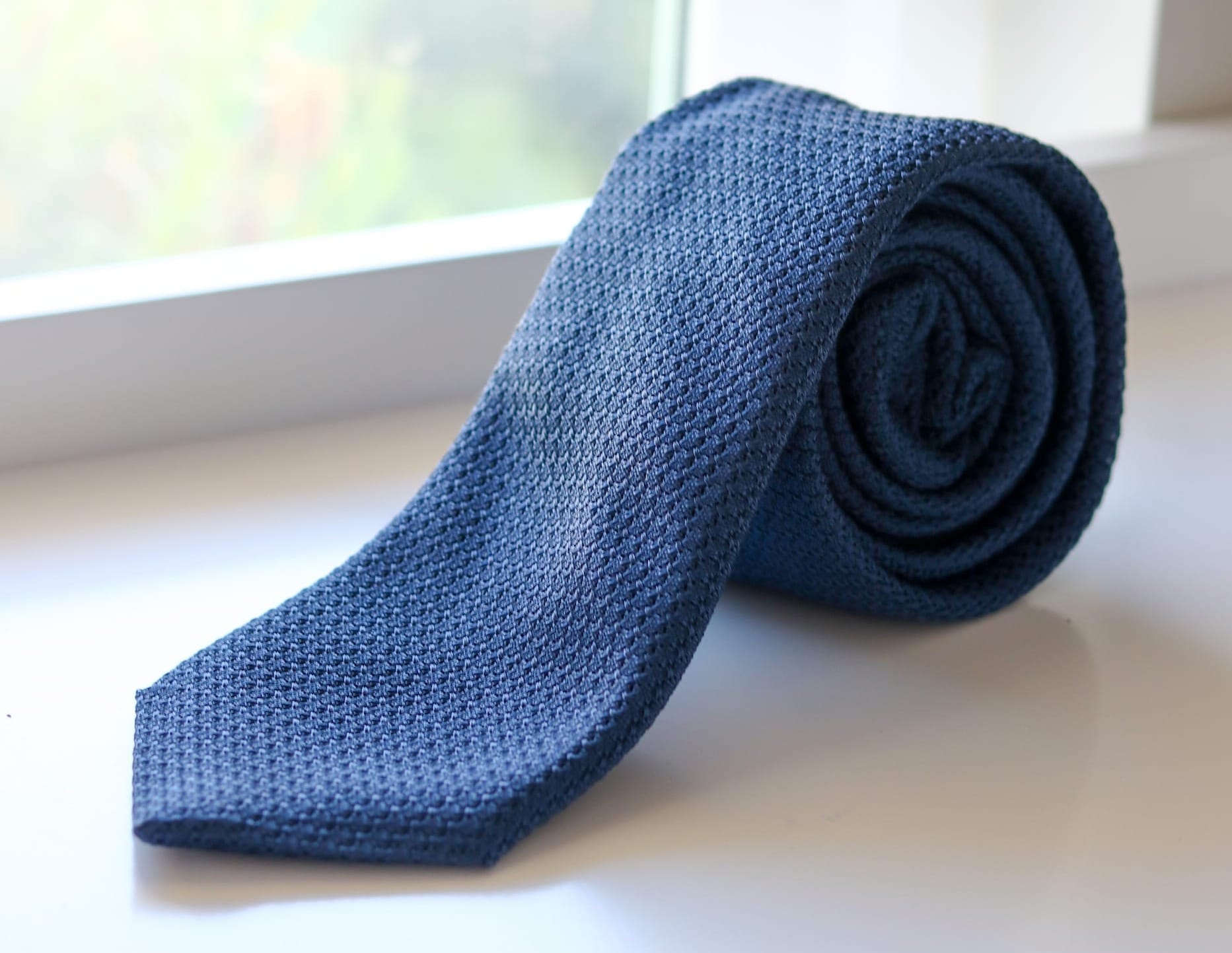
A classic navy grenadine tie ought to be your first necktie because of its timeless pedigree in men's style, sophisticated texturing, and highly versatile qualities. Grenadine is traditionally a silk material with much more texture and thickness than conventional silk neckties.
This texture is excellent for business casual outfits incorporating other textures, such as hopsack, flannel, and linen. Consistently mixing various tasteful textures can create cohesion throughout any man's appearance.
Concerning business casual attire, the texture of the grenadine fabric enables the wearer to dress this necktie up or down more quickly than a standard, shiny silk necktie.
Piece #15: Navy Peacoat
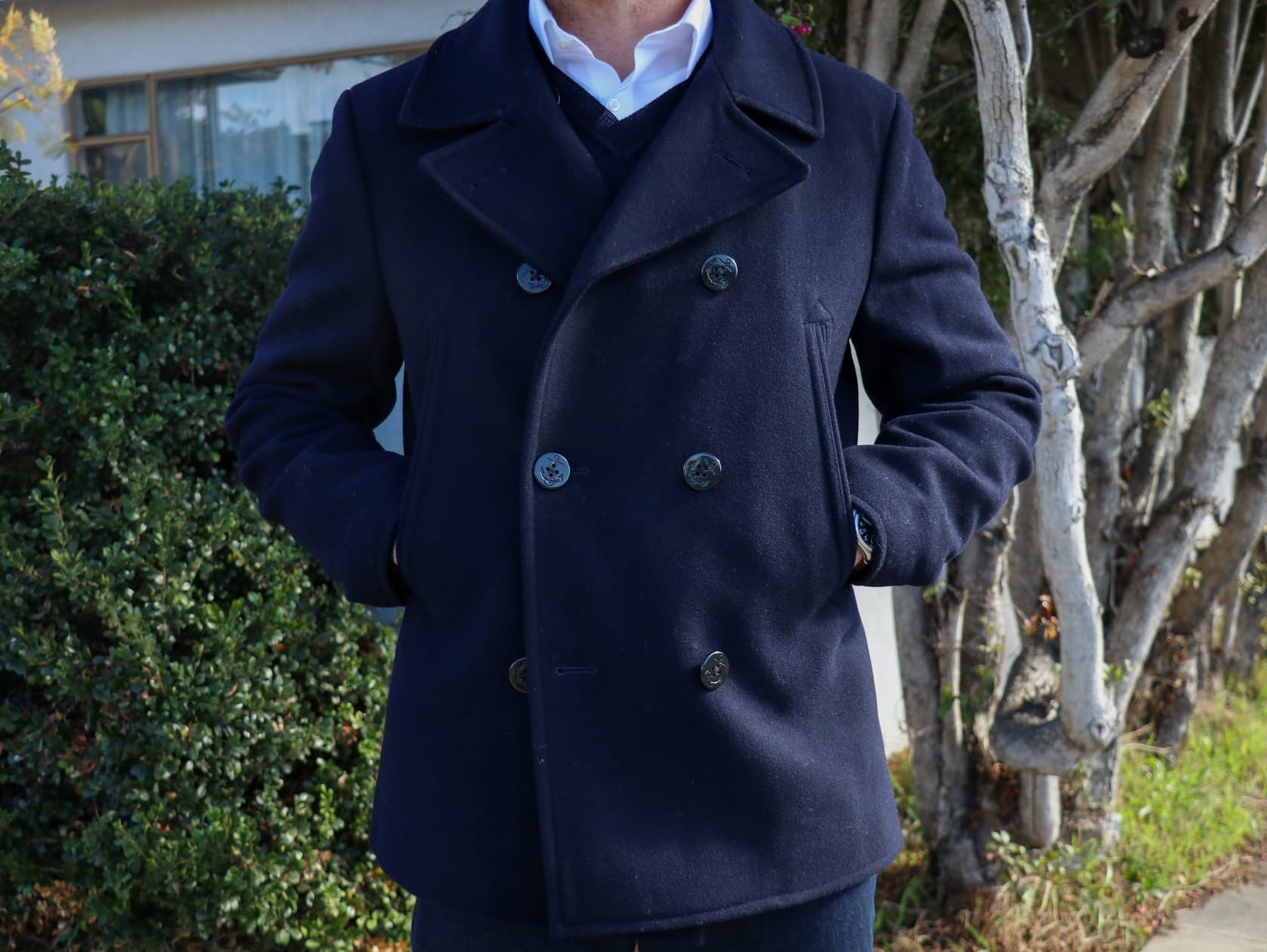
Of course, sweaters might not always be enough to keep you warm (depending on where you live and the weather you encounter).
Overcoats, car coats, quilted jackets, and cardigan sweaters are excellent choices for providing warmth and elegance while on your way to the office. Still, if you ask me, one of the most underrated outerwear choices for men is the classic navy peacoat.
Think of this as the "coat version" of a navy blazer because it can be utilized similarly. If this is too thick and heavy for you, a cardigan sweater is also appropriately stylish.
If it rains where you reside and you are less worried about warmth and more concerned with staying dry, consider something like a classic water-resistant trench coat to incorporate into your work capsule wardrobe.
9 Outfit Ideas & Styling Tips
Now that we have our pieces, let's look at a few examples of outfits we can create for the workplace. Featuring every type of outfit possible with each of these fifteen items would make this guide far too lengthy.
Outfit #1: Casual Polo & Khakis
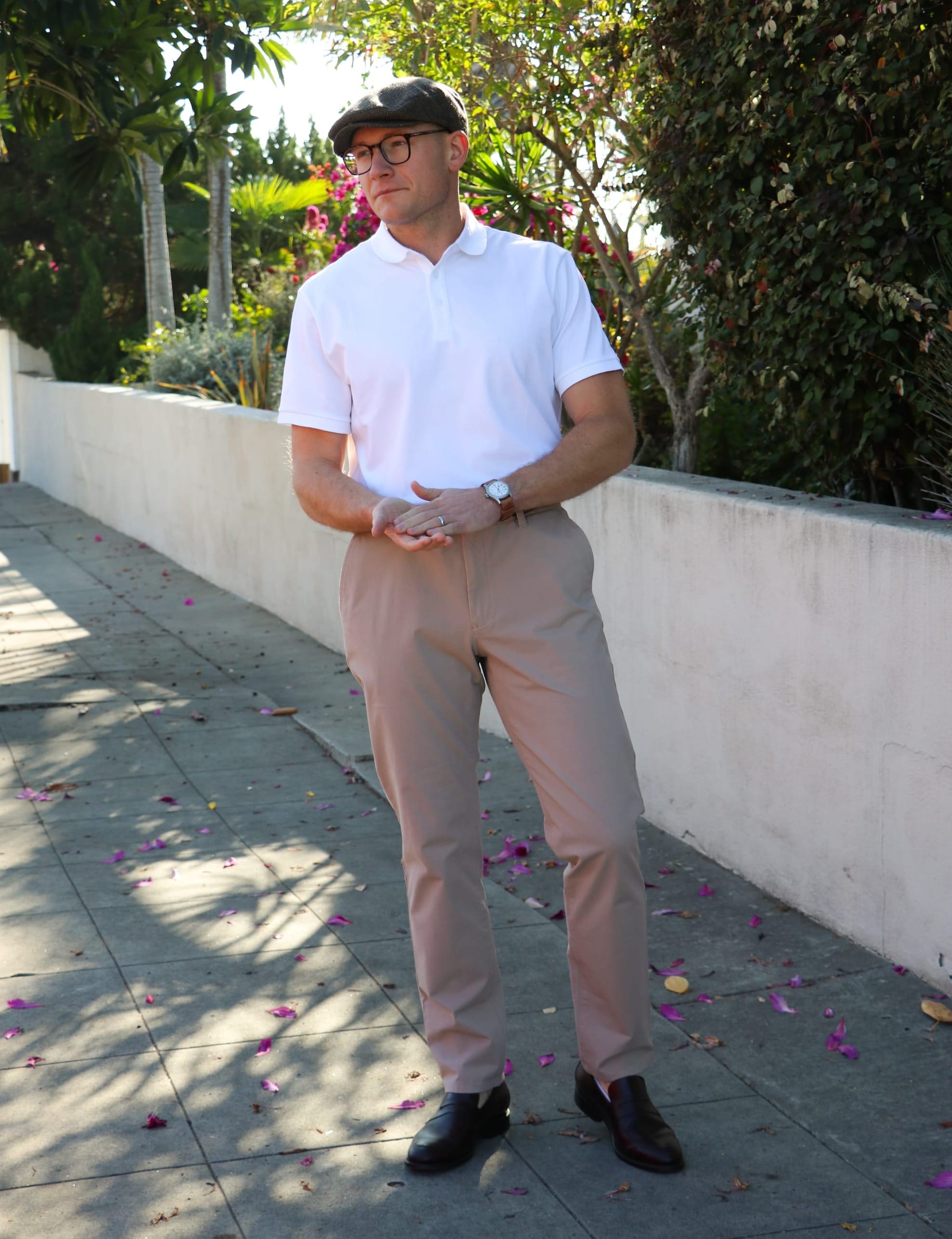
Here’s how to effectively wear a classic white pique polo shirt. When paired with khaki chinos and polished brown leather loafers, this ensemble exemplifies a "casual" business casual outfit for men. Tucking in the polo shirt adds a touch of formality, and the fit of the chinos is on point.
Just be sure to match your leathers when adding a belt!
Outfit #2: Business Casual Blazer
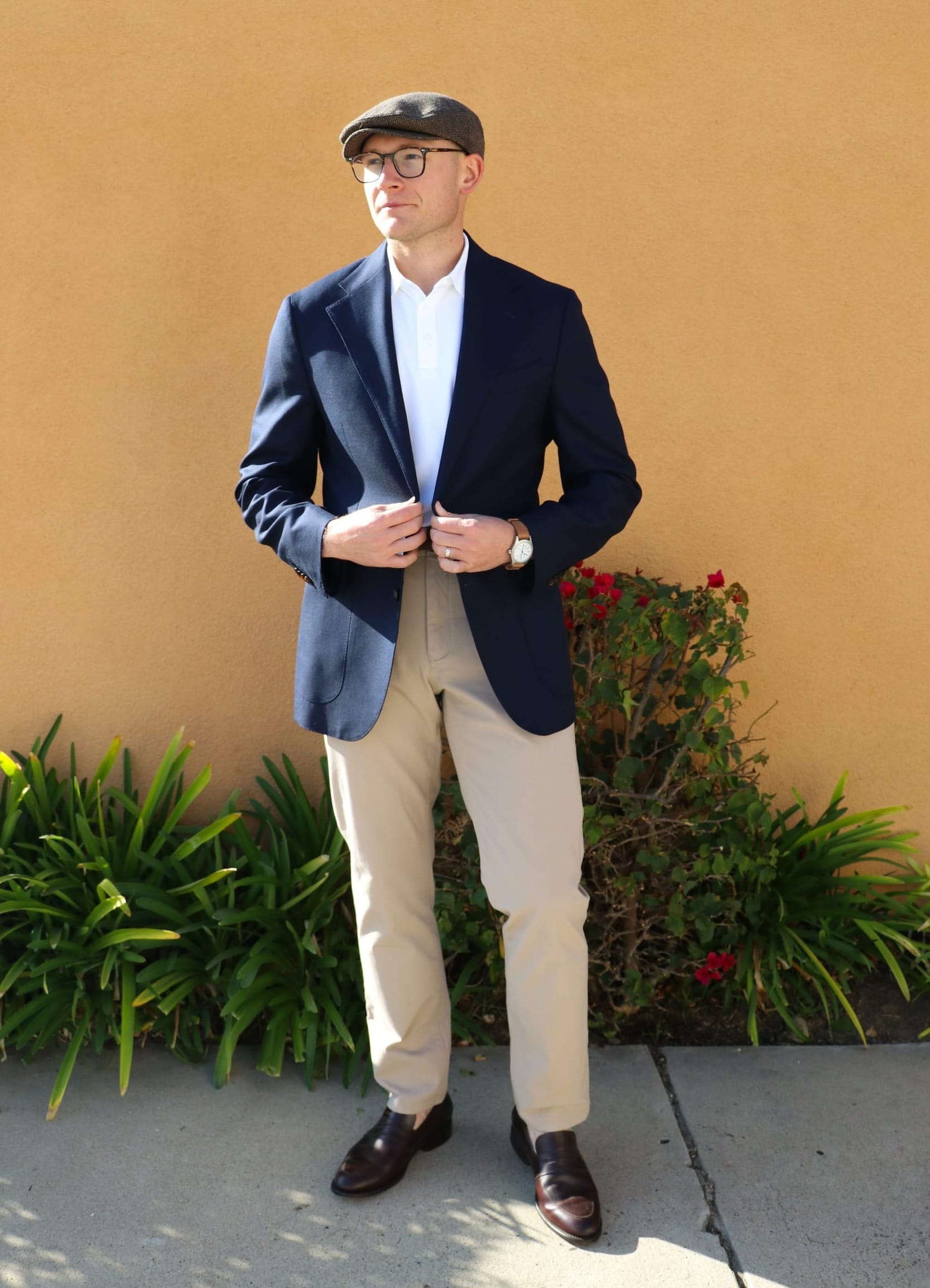
Let's elevate that outfit from before a bit.
Just add a classic navy blazer, and voilà! You're all set for the last-minute afternoon meeting with the boss. That's the power of a well-fitted navy blazer and sport coat. Incorporating a timeless outerwear piece can transform most looks by allowing the base outfit to be easily complemented.
Outfit #3: Smart Casual Blazer
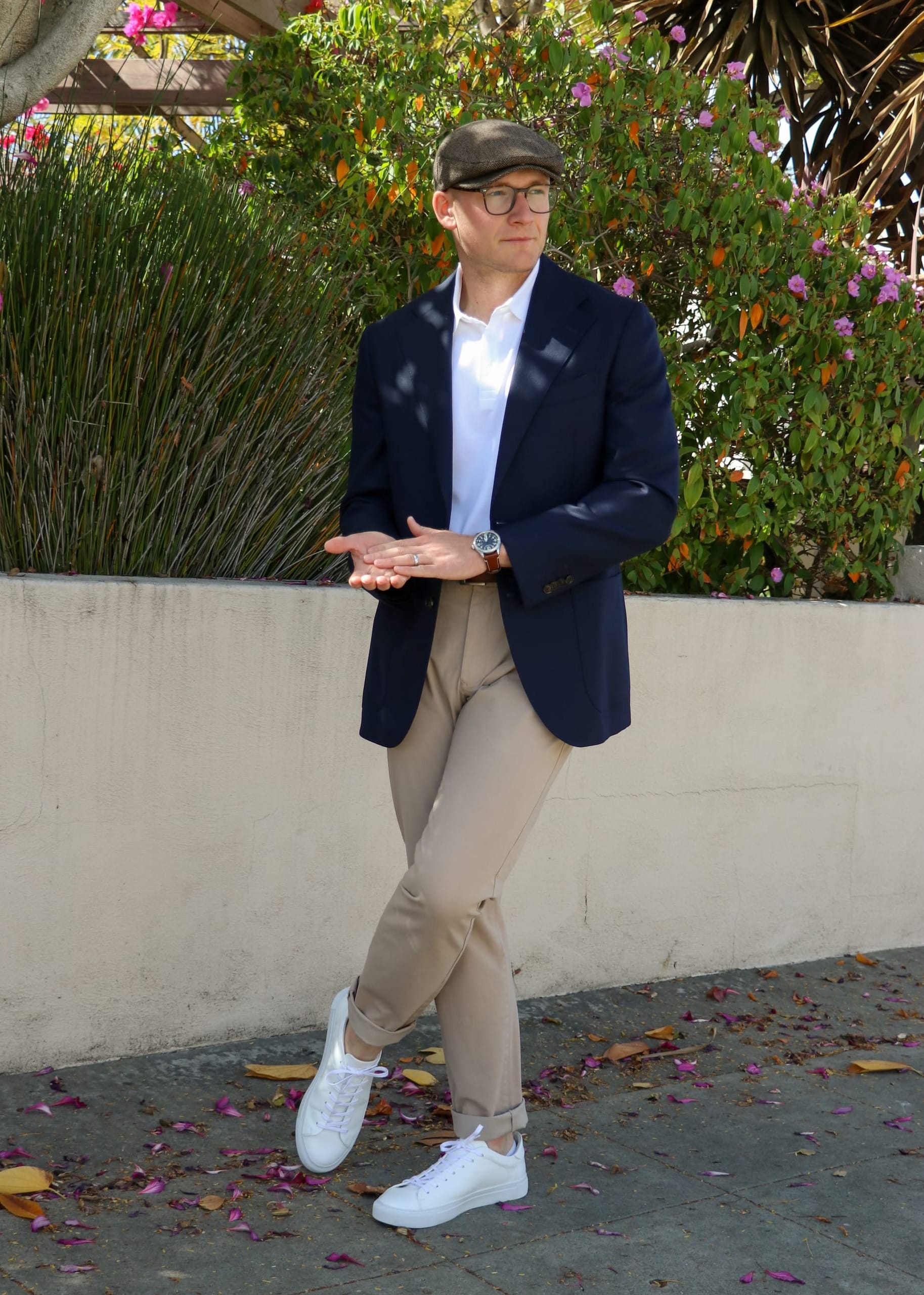
I'm wearing the exact same outfit as the previous one, this time with a more "smart" casual twist.
Twenty years ago, an outfit like this wouldn't have been acceptable in almost any office setting, but today, the definition of "business casual" has changed dramatically.
Adding clean white leather sneakers and cuffed khaki chinos may not be a style everyone can adopt at work. Still, depending on how your boss defines business casual, this could be a great way to modernize and ultra-casualize a traditional business casual look while still firmly keeping it within the smart casual category of the business casual spectrum.
Outfit #4: Smart Casual Sport Coat & Jeans
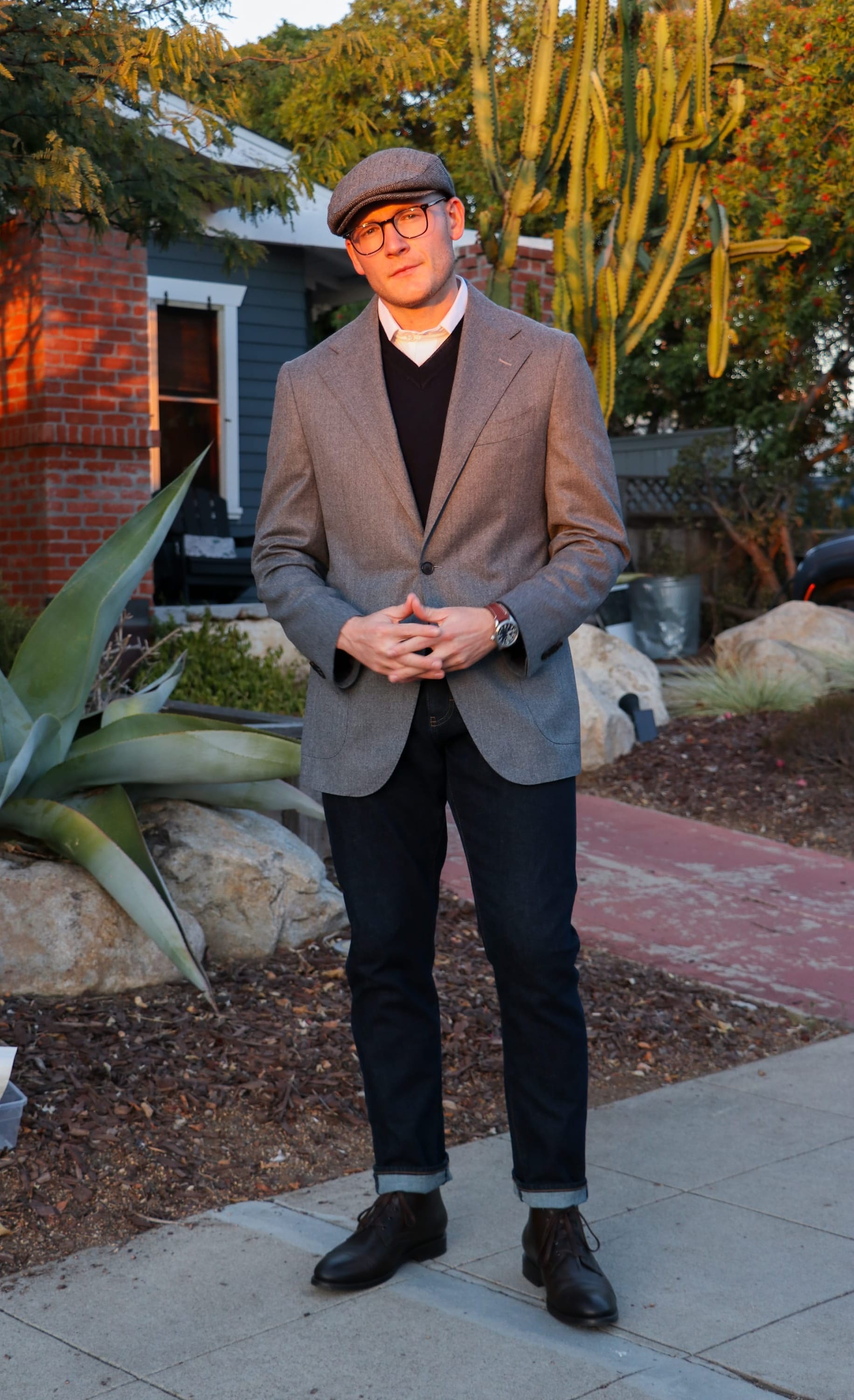
Dark wash jeans look excellent when paired with neutral-colored sport coats that contain a fair bit of texture.
Take, for instance, this gray flannel sport coat. It provides texture and warmth and pairs exceedingly well with the navy v-neck sweater layered on top of a white dress shirt.
If you opt for these warmer fabrics, it's likely to be brisk outside, so wear dressier lace-up boots in a deep brown tone. This is an excellent example of incorporating dark wash jeans into your business casual wardrobe (provided your place of work allows them).
Outfit #5: Formal Business Casual Blazer

Here is an example of a more formal business casual outfit for men.
Once again, you're probably accustomed to seeing a look like this in movies, television, magazines, or online. This classic menswear "uniform" will always stay stylish for dressier office occasions.
My navy blazer is paired with handsome wool flannel dress pants, a white dress shirt, and a textured navy grenadine necktie, all harmonizing well with the various textures in the outfit.
Naturally, brown suede oxford dress shoes make a logical choice due to their rich texture and deep color.
Outfit #6: Smart Casual Sport Coat
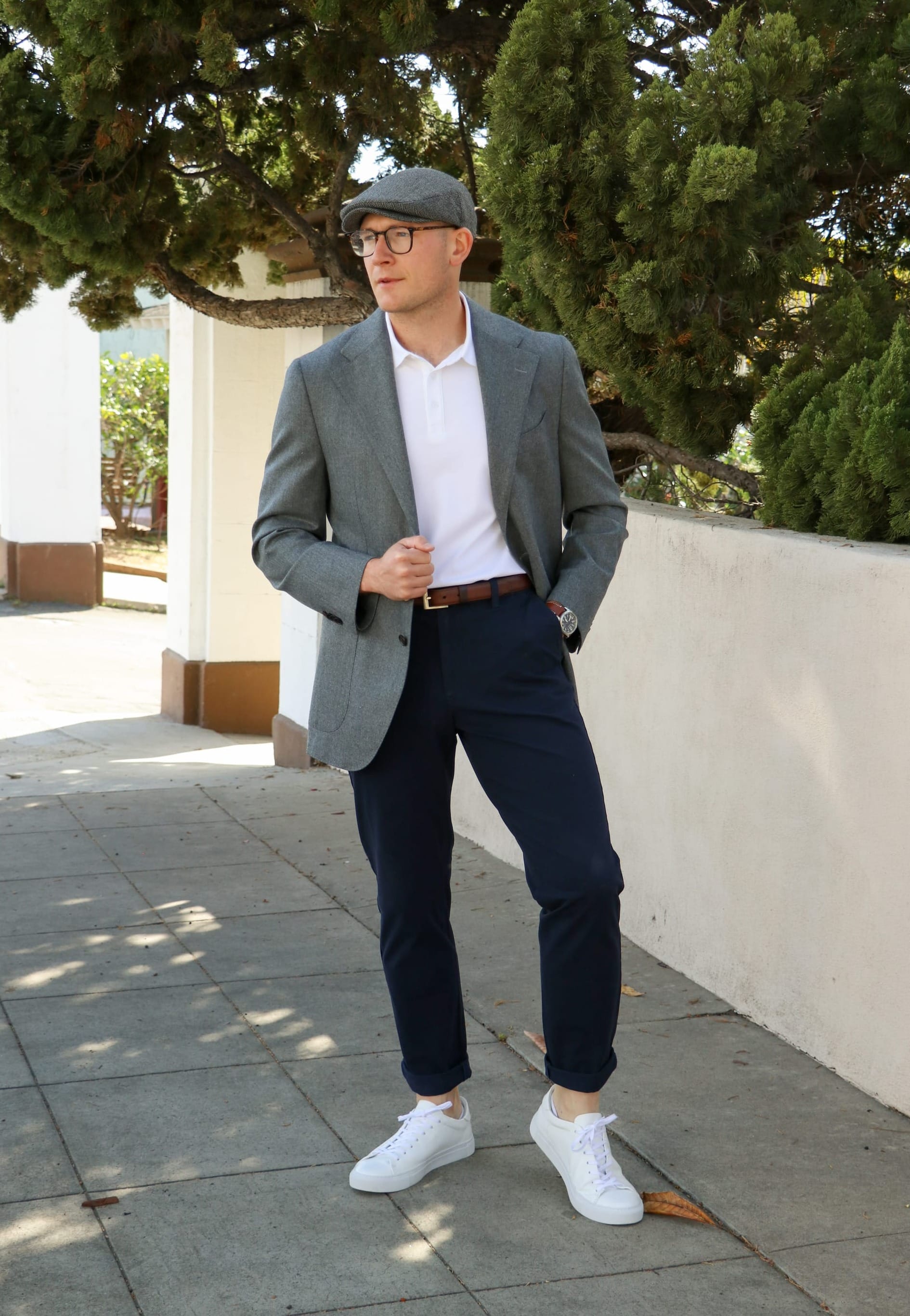
Here’s another smart casual outfit featuring clean white sneakers, this time with a gray sport coat, classic navy chinos, and a white pique polo shirt. Notice how this is a very similar styling option to the previous smart casual blazer outfit with khaki chinos.
It's the same style but a different vibe.
Outfit #7: Formal Business Casual Sport Coat
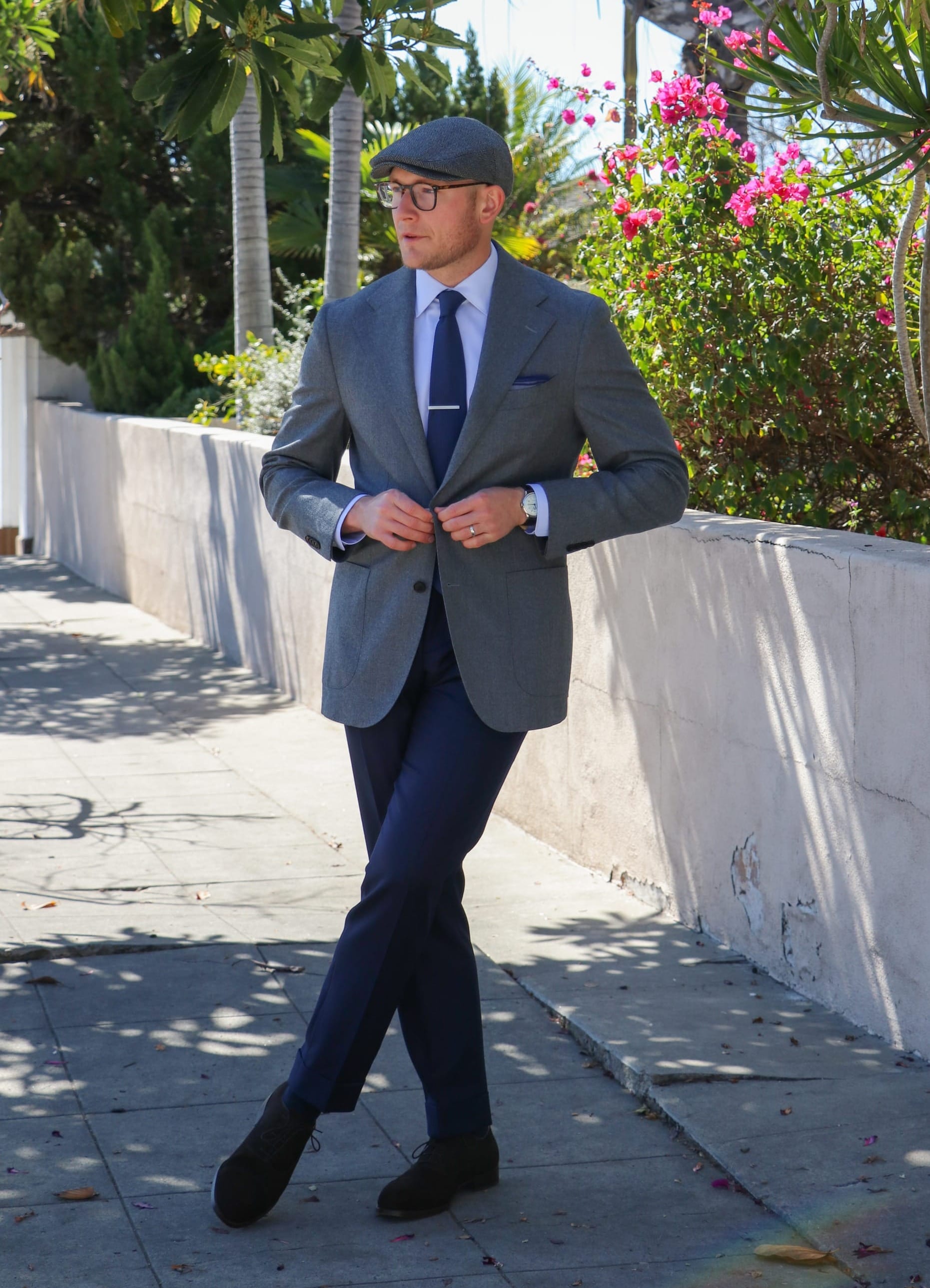
This outfit features the same mid-gray flannel sport coat as the previous one, but this time, it is clearly more "business" than smart casual.
Paired with a classic ice-blue oxford-cloth dress shirt, brilliant navy wool hopsack dress pants, and richly textured suede dress shoes, this represents one of the most classic business casual outfits you can find.
Outfit #8: Smart Casual Peacoat
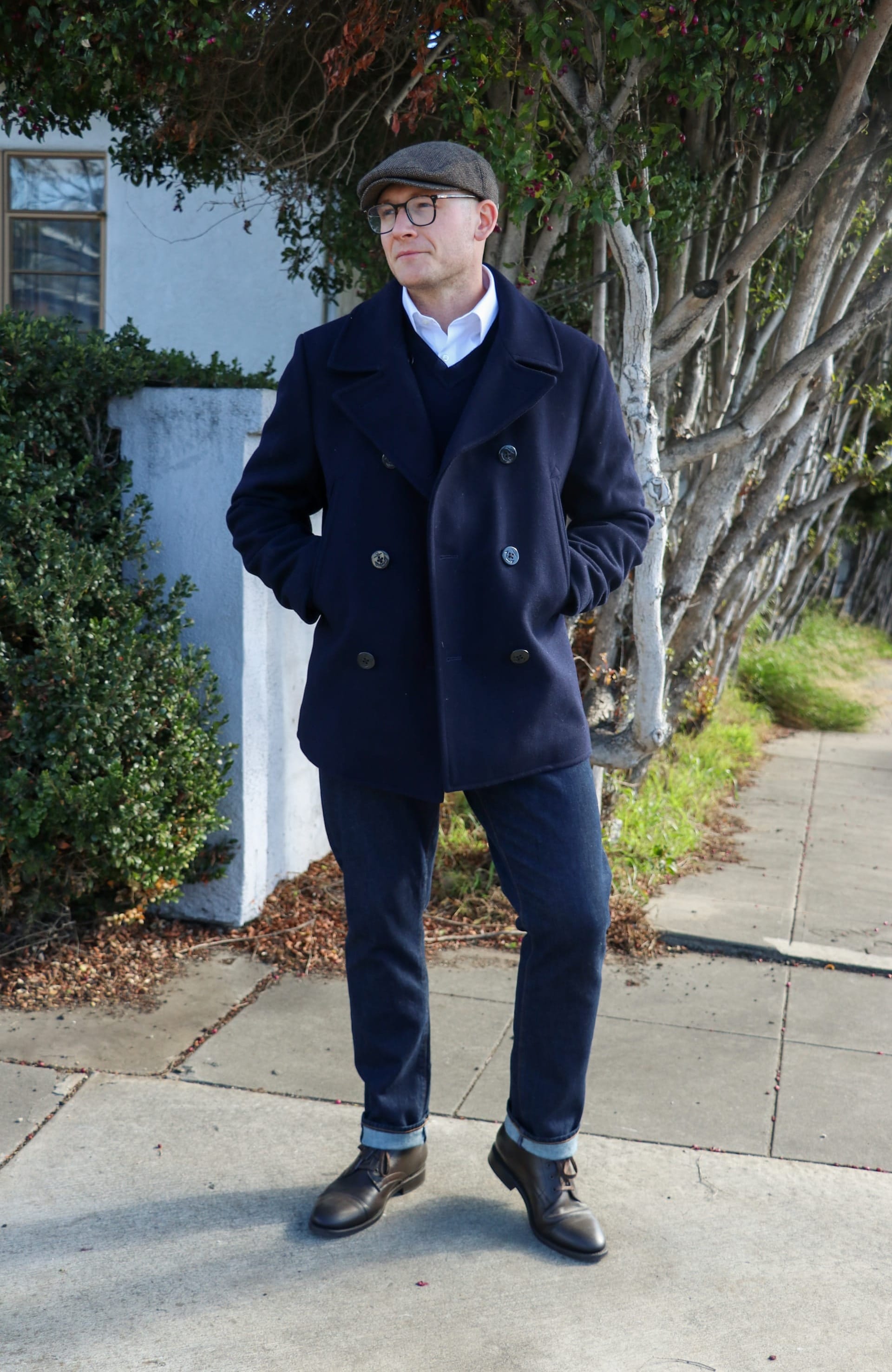
Do you remember what I mentioned about the peacoat working like a navy blazer? Here's an example of what I'm referring to.
A white dress shirt, navy v-neck sweater, dark wash jeans, brown cap-toe boots, and a classic and masculine navy peacoat. Maybe it's my naval heritage talking, but the peacoat is hands down my favorite thick outerwear coat (and it could very well become yours too).
Try it and see.
Outfit #9: Formal Business Casual Peacoat
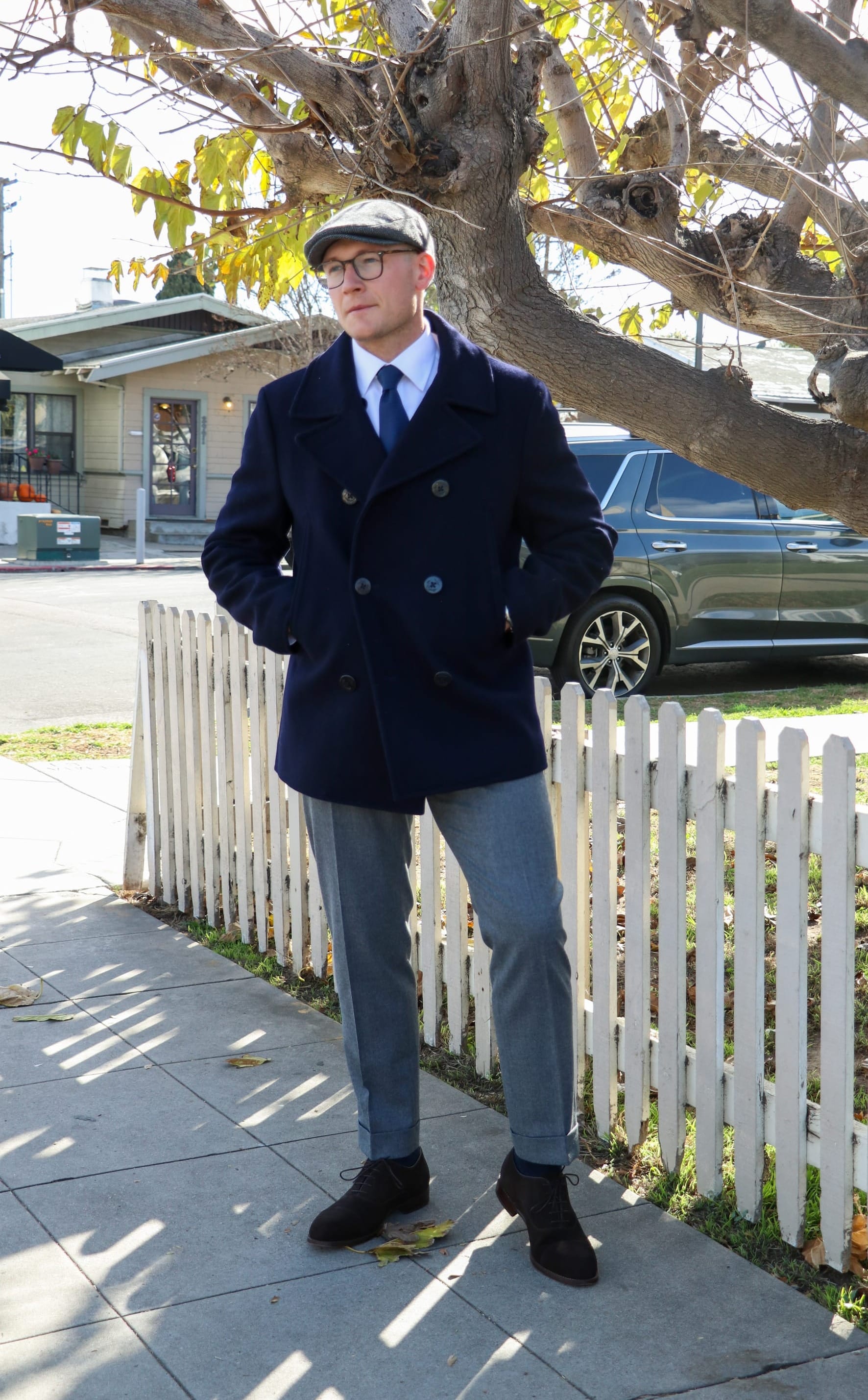
Indeed, we can always elevate the navy peacoat to a significant degree, just like our classic navy blazer. Hooyah!
The Business Casual Wardrobe Made Easy
The value of a business casual capsule wardrobe is undeniable. I hope this guide has been helpful, especially if you want to look professional on a budget or address any wardrobe gaps.
Depending on your geographic location and the need for extra layers, this business casual capsule wardrobe should meet your needs at the office, regardless of how your managers define the business casual dress code.
Whether you use these pieces for work or casual outings, you should feel confident in what you wear, as long as the clothing fits well.
After reading this guide, I hope you now understand what a business casual dress code involves, what it should look like, how the smart casual dress code fits into it, and how to maximize the potential of your wardrobe by working smarter, not harder.
Sticking with these fifteen essential pieces will help you maintain a stylish and versatile wardrobe that stands the test of time.

